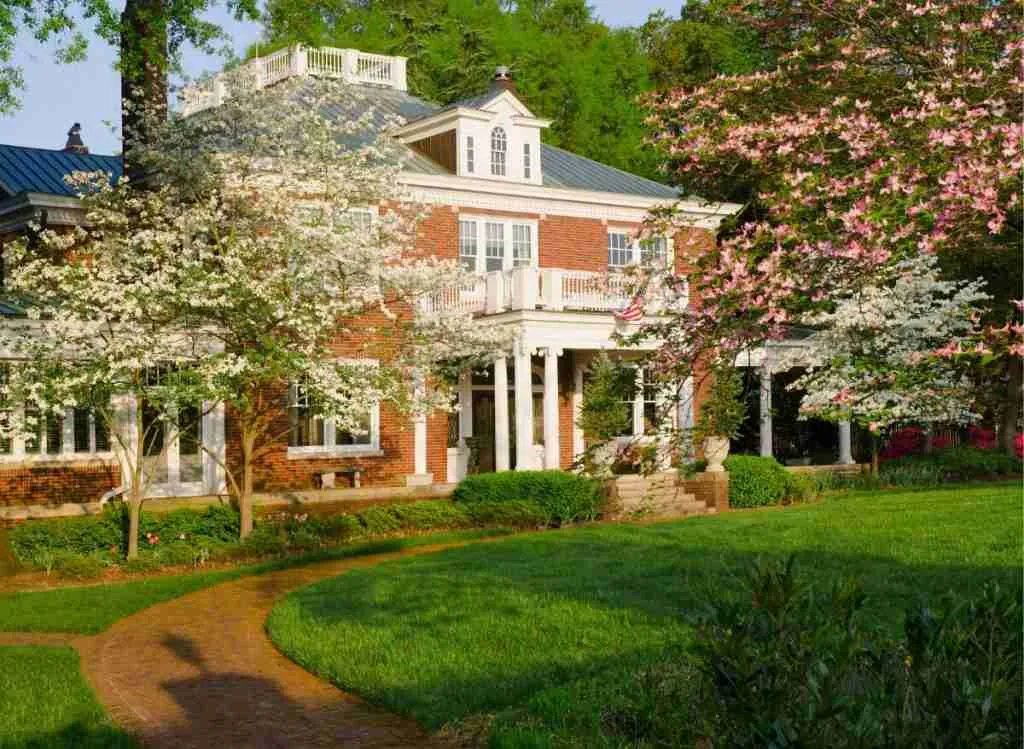
The dogwood tree is a beautiful ornamental tree to add to your garden or property. In fact, dogwood is one of the prettiest flowering trees in the US. In springtime, it offers bold white flowers, gracefully and horizontally arranged green leaves on branches in summer, and the burgundy fall color and bright red fruit that birds favor in autumn.
However, watching dogwood trees die after all the hard work you have put in can be extremely devastating. So, can you revive it? If so, how to revive a dogwood tree?
You can save your dogwood tree by:
- Mulching
- Improving the soil drainage
- Improving its soil pH
- Pruning it
- Using pesticides
- Moving the dogwood tree under the shade
Read on to find out how to properly care for a dogwood tree, the common reasons a dogwood tree dies, and how you can successfully save your dogwood.
See also: How Far From Your House Should You Really Plant a Dogwood Tree? (Let’s find out!)
Common Signs of Dying Dogwood Tree
- The most common signs of a dying dogwood tree appear in the bark or leaves. For example, peeling bark can be a good sign that your dogwood tree might be suffering.
- Inspect the base of your dogwood. If you notice mushrooms or a dead area surrounding the tree’s base, the tree might be in trouble.
- Check your dogwood’s leaves thoroughly, and if you see curled leaves, too small leaves, and leaves with scorched spots, it could indicate that your tree needs help.
See also: 5 Most Important Spider Plant Diseases You Need To Look Out For
How To Revive a Dogwood Tree?
Here are a few tips on how to save your dogwood tree from dying:
1- You Can Revive a Dogwood Tree with Mulching
Summertime evaporation can cause the soil to dry and form cracks leading to the death of the dogwood tree. To preserve moisture, you can use mulching material to dig around the base without touching the tree trunk.
Mulching plays a vital role in cooling the soil and keeping the desired soil moisture for the healthy growth of your dogwood plant.
In addition, regularly inspect your garden, particularly during summer, and if you see wilting, water the tree immediately and deeply and apply mulch.
Add several inches of mulch around the bottom of the dogwood tree without touching the trunk. The mulch will help cool the soil and retain moisture. Inspect the leaves regularly during hot, dry spells.
2- Reviving a Dogwood Tree By Improving Soil Drainage
If the growth site is draining water fast, which results in excessive dryness that leads to your dogwood tree’s possible death, consider blending with loam soils or clay soil to promote water retention.
Similarly, if the growing site maintains lots of water throughout heavy rain, it will create waterlogging. To prevent the death of your tree, try mixing the soil in your growing area with sandy soil with high drainage.
You can also transplant your dogwood tree to another area where the soil has a suitable pH and proper drainage.
3- Reviving a Dogwood Tree By Improving Its Soil pH
Dogwood trees thrive in acidic to neutral soil, varying between 5.5 to 7.0 PH. But, if the soil is alkaline, the plant will have yellowing leaves, indicating that they are not receiving sufficient food through photosynthesis required for healthy plant growth, and alkaline soil leads to dogwood trees’ death.
Whenever you see signs that the dogwood plant is dying, the problem possibly lies with the soil pH.
You can prevent it by testing the soil, and if your soil has insufficient nutrients, you can improve it by using fertilizers and helping revive your dogwood tree.
See also: Easy Ways To Turn Granular Fertilizer Into Liquid Fertilizer
4- You Can Revive a Dogwood Tree By Pruning
If a spot anthracnose fungal disease infects the dogwood tree, it will most likely die. Generally, this disease spreads through water splashing from the plants’ leaves.
If you have other plants near the infected one, consider transplanting them to a healthier spot.
You can prevent this issue by pruning the diseased branches and removing them from the field.
- Prune and destroy or bury infected leaves and branches throughout fall and winter.
- Rake and dispose of fallen leaves and branches during the dogwood tree growing season.
5- Reviving a Dogwood Tree By Using Pesticides
If you see holes in the branches or stems of your dogwood tree, use pesticides to exterminate the dogwood borers before spreading.
In case the dogwood tree is not revivable, remove and burn it to prevent the pests from spreading to others. I recommend you transplant the remaining healthy plants to a different location because some pests might hide in the soil.
And avoid planting the trees back near or in the exact location for the next 1 or 2 seasons to help exterminate those pests.
6- You Can Revive a Dogwood Tree By Moving It Under The Shade
Dogwood trees grow well in cool or cold weather, and a lot of suns can affect their growth and health.
If your dogwood trees receive too much sun exposure, particularly during summer, consider moving them to an area with shade.
See also: 5 Common Hibiscus Plant Diseases You Need To Know About!
Common Reasons a Dogwood Tree Dies
It is an unfortunate fact, but many dogwood trees in Canada and the United States are getting sick, and the most common cause of death is from dogwood Anthracnose. This disease primarily infects flowering Dogwood (Cornus florida) and Pacific Dogwood (Cornus nuttallii).
Here are the most common reasons a dogwood tree dies.
Plants Diseases
Many diseases might affect the dogwood trees, which results in their death. Fungal infection (AKA dogwood anthracnose) is a devastating disease that infects dogwood during the flowering stage.
The first indication of anthracnose is spotting on the leaves and flower bracts. In cooler weather, you may also notice drooping leaves. And, as the disease spreads, it causes sunken brown areas encircling and killing branches.
This infection affects most dogwood trees throughout Canada and the northwestern U.S., killing several infected trees.
Pests Problems
Pests are another common reason why dogwood trees die. The dogwood borer causes holes in the main stem and branches, resulting in vital structural deterioration. Generally, powdery mildew and borers enter damaged trunks.
Ultimately, the tree will develop seeping cracks in the trunk and then fill with sawdust. Too many of these holes will prevent nutrients from flowing, causing the plant’s death.
Boring Insects are the most common threat to a dogwood tree. The flat-headed appletree borer and the dogwood borer are two types of boring insects that can infect your dogwood tree.
An early sign of borers is bark sloughing off or small wet spots on your tree.
See also: Top 10 Best Beneficial Pests For Gardens
Poorly Drained Soil
Dogwood trees require proper drainage to thrive, and poorly drained soil can cause waterlogging or dryness, which will result in their death.
For example, clay soils are suitable for planting dogwood trees because they maintain a lot of water.
Whenever possible, mix your growing soil with sand soil to promote proper drainage.
Also, sandy soils have poor water retention, and during summer seasons, your dogwood tree will need regular watering; unless you provide it with constant watering, the plants will die.
Crown Canker
Crown canker can make your dogwood have tiny leaves lighter in color and may curl around the edges. As the disease spreads out, you may see twigs and branches dying on one side of the tree.
If you look closely, you will see a dead area at the bottom of the tree that slowly circles it and eventually kills it.
In general, a crown canker can be fatal to a dogwood. But, if you detect it early, you can try cutting out the canker and two inches of healthy bark.
It is better to prevent crown canker than treat it. Ensure you keep your dogwood from getting any wounds, which make it exposed to the disease.
Leaf Scorch
Exposing dogwood to too much sun or not providing it with enough water will cause leaf scorch.
Dogwood trees grow in an area where they receive lots of shade. When you notice that the edges of your dogwood’s leaves are turning brown, it is time to water it.
The good news is that leaf scorch will not kill your dogwood tree unless left untreated.
See also: How To Successfully Kill Blackberry Bushes: A quick guide.
How To Properly Grow a Dogwood Tree
Planting dogwoods requires an ideal site.
- If you decide to plant dogwoods, ensure you choose a spot with deep, rich, well-drained soil.
- A lighter shade is better than a heavy shade.
- Ensure your dogwood receives sunlight in the morning and protection from the hot afternoon sun.
- Put lots of leaf mulch around your planted dogwood to provide a natural source of fertilizer. You can use a layer of pine straw.
- Adding lots of leaf mulch around will prevent mowers and weed whackers from cutting in close, therefore avoiding trunk wounds.
- As the dogwood tree grows, don’t plant much beneath it and avoid disturbing its roots.
- Adding leaf mulch will help keep dogwood roots cool and conserve moisture.
- Drought will stress and kill your dogwood, so pay attention to watering, particularly for the first year and throughout extended droughts.
- Without the proper soil, dogwood will not thrive and flower.
See also: 5 Of The Best Companion Plants For Your Olive Trees You Need To Know About!
Wrapping Up
Dogwoods are beautiful trees that can transform your garden into a paradise, particularly in the spring. If you decide to plant dogwood, remember these have some special requirements.
Regularly inspect your tree to keep it healthy and thriving because it is always better to prevent most dogwood diseases and pests than to treat them.
By providing your dogwood with the proper environment and care it requires, you will benefit from its beauty for decades to come.


